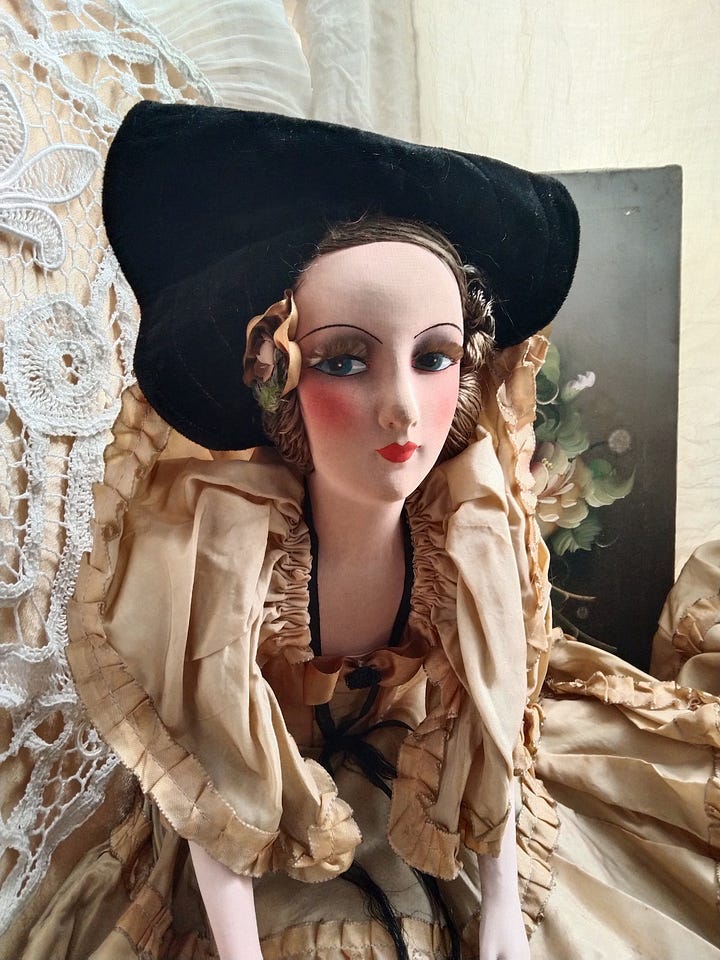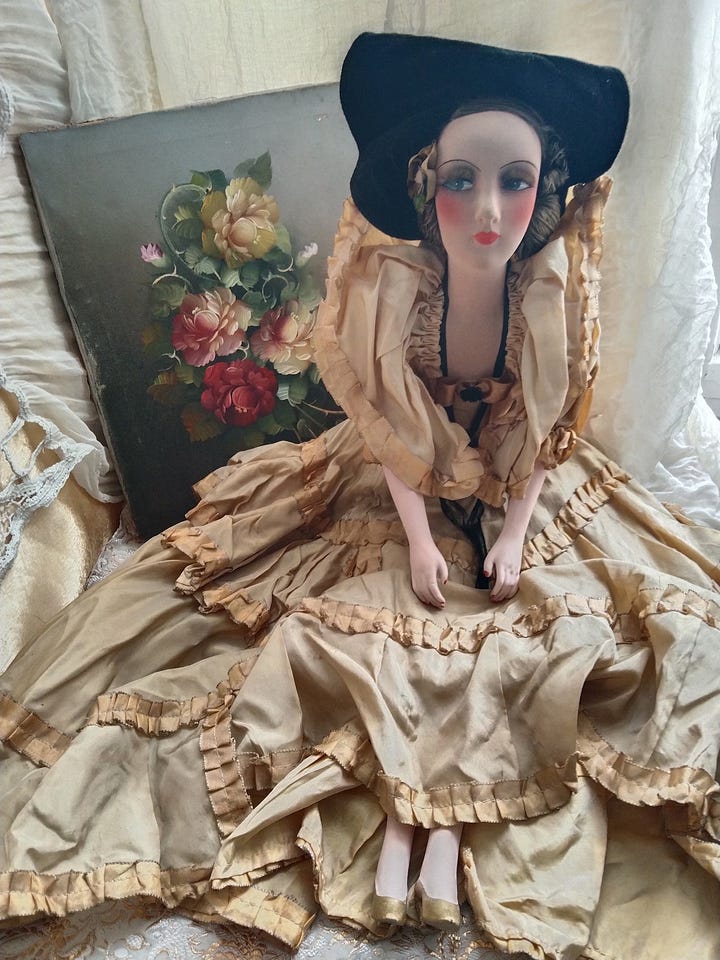searching for the boudoir doll
the flapper's silent and childlike companion: beginning the search
As a (semi) recent graduate of a MA in Design History, my most recent and ongoing hyper fixation is the boudoir doll, the long-limbed, rag doll that were collected by fashionable flappers in the early twentieth century, reaching peak popularity in the 1920s. The doll, with her porcelain body, long limbs, large, painted eyes and pouty lips were an inspiration for the flapper’s recognizable style. This fashionable relationship was cyclical, and soon the flapper’s modern look was reflected back in her dolls, who sported miniature versions of their dresses and bob haircuts.
Also known as “smoking dolls,” “bed dolls” and “salon dolls,” the boudoir doll was a decoration for her boudoir, a gift from a current lover, or an accessory, hanging off her arm at a party. Many of these dolls accompanied her in portraits and boudoir photography, intentionally posed and dressed like her miniature double.

For me, the presence of anxiety, fear of the uncanny, alienation and abjection are key to the study of the doll and her uncanny counterparts (the mannequin, the puppet, or the automata) at the turn of the century. During this period, the doll became a muse and a nightmare within a rapidly industrializing, and alienating, modern world. Many artistic works from this period interacted with “the doll” and the uncanny. I have studied many of these works alongside the writing of Sigmund Freud, Julia Kristeva, Rainer Maria Rilke and Simone de Beauvoir, viewing these works as expressions of internal anxieties surrounding the instability of modern identity and the shifting boundaries of subject and object during this period.
But what does this mean for the popular long-limbed boudoir doll?
The era’s obsession with “the doll” has been studied, and I am of the opinion that this study is an important facet of the cultural and material history of this period. However, the flapper’s relationship with her dolls, as a collecting practice, an accessory and decorative object has not received the same level of scholarly pursuit, or attention within the doll community.
In the company of their flappers the boudoir doll becomes a slightly humorous (and silent), fashionable companion, a connection to a childlike wonder that must have felt especially distant among ongoing threats of war and Fascism, and increasing alienation. It is with this awareness that the boudoir doll becomes fascinating to me, and an entry point to understanding the era’s “doll-craze.” I would like to use my Substack, as a space to document this research and speculate on my findings. I see this as a somewhat casual entry point to discussion about dolls and their representations during this period, but also doll collecting as a part of women’s material history (and why so much of it is lost to us).
Beginning the Search
As previously mentioned, the boudoir doll has not received the same level of scholarly attention as some of her doll counterparts (a subject that is already lacking in attention). Some boudoir dolls have been collected by museums, however, the majority of them still remain in personal collections and are more commonly found at Doll Shows, or are being sold through auction (including personal sale on eBay or Etsy).
I will note that my interest in boudoir dolls is not limited to a research interest, I also love how they look. I enjoy their long limbs and rag doll bodies, their connection with fashion and their flapper make-up. I also enjoy their marginal reputation within the doll community.
I have always loved dolls, and my childhood relationship with them has progressed into a desire to study them as a part of our material history. (I have probably modelled some of my own sense of style off of them as well). However, inside there is also a younger version of myself, who so loves a doll, who loves their pretty faces, brush-able hair, tiny hands and pointed feet. Who wants to dress them in beautiful outfits, hold them and make them real.
In my love of dolls, I can’t help but find a connection with the flapper and her doll collection. If I had the means (aka. $400+ to spare), I would also be collecting boudoir dolls, such as this one (pictured below) from the 1930s, currently being sold by French Etsy seller, Parisladiesandco (linked here).


Doll research is deeply entwined with doll collecting, and with the boudoir doll, it appears that this connection is especially pertinent. It is through eBay, Etsy, estate sales, auction houses, and early internet databases compiled by doll collectors for doll collectors, that I must start my search. It is also through my own personal joy of dolls, and ongoing interest in the boudoir doll (beginning long before I entertained a MA degree) that my research begins.
In future Substack posts, I hope to connect with other doll lovers, and continue to document this search, sharing more information on the boudoir doll, and the “doll-craze” in the early twentieth century, including responses to writing and/or film, historical photographs, and popular boudoir doll creators (like Lenci). I may also share research on other subjects and personal essays as well.



